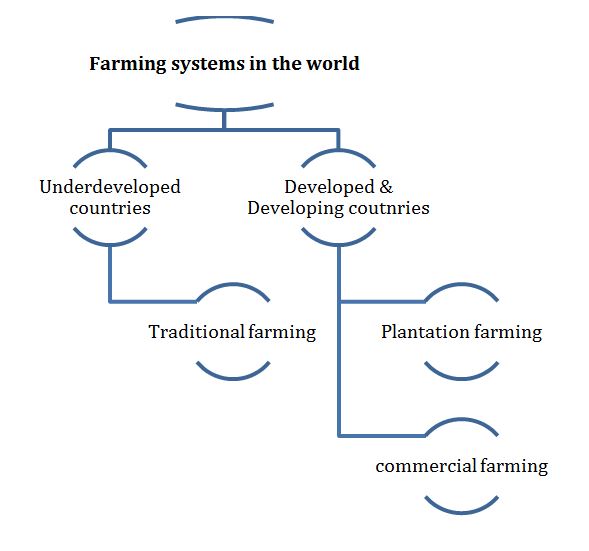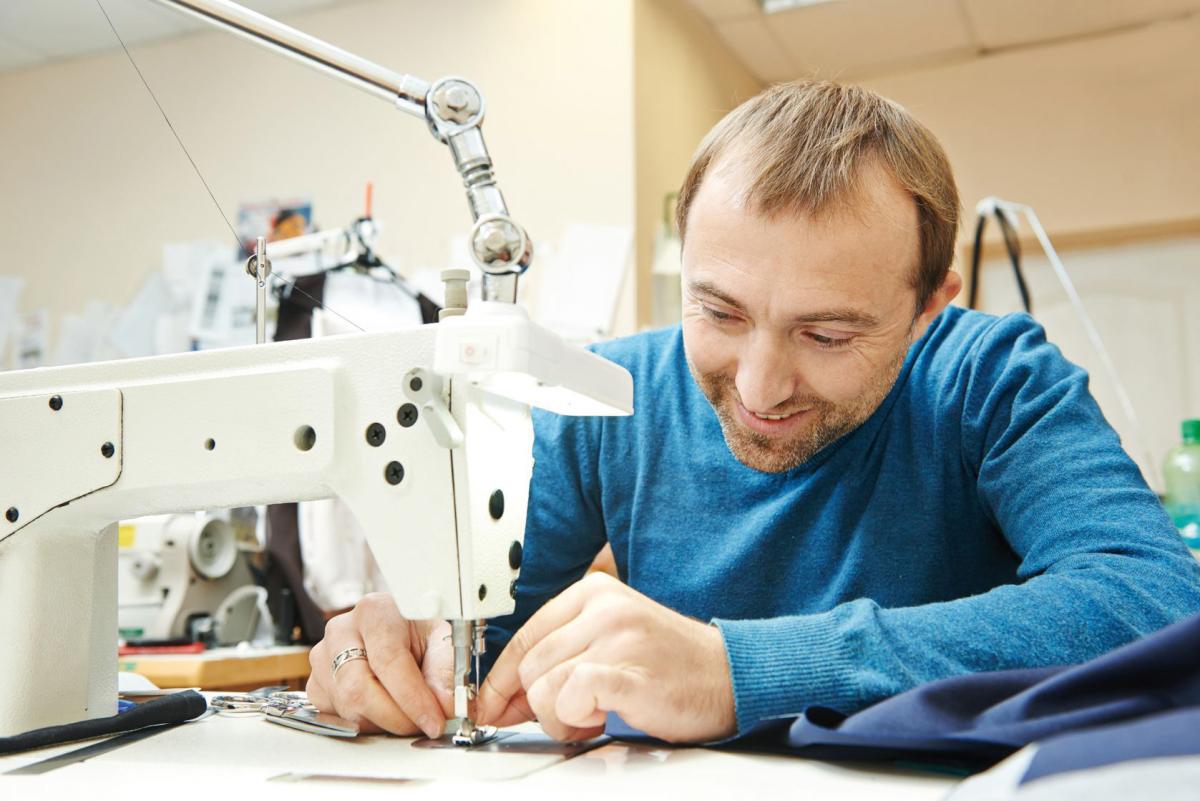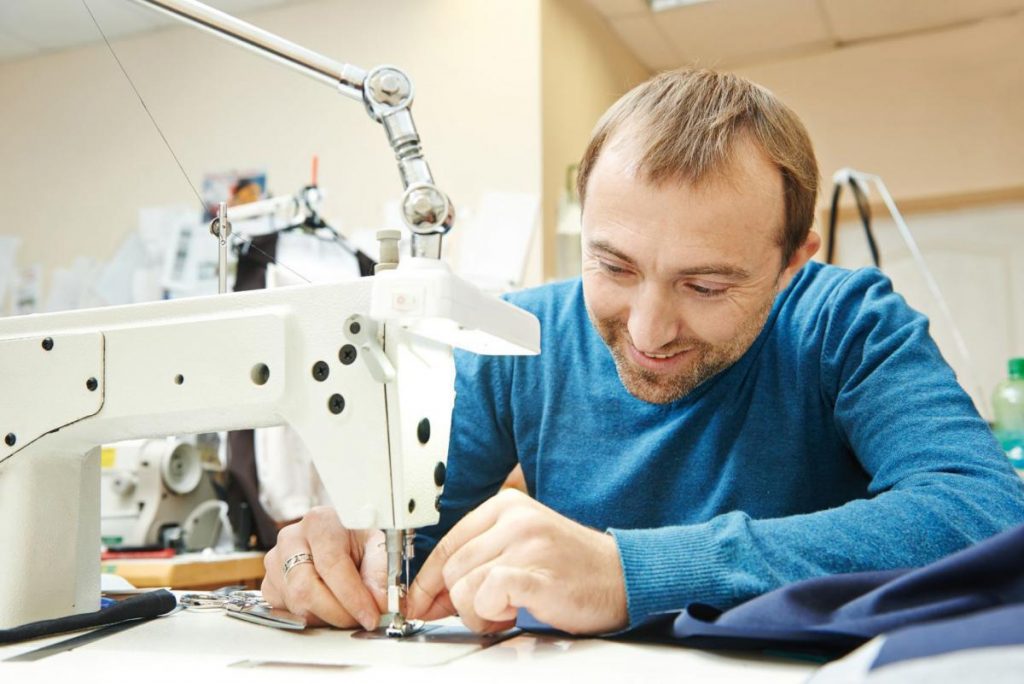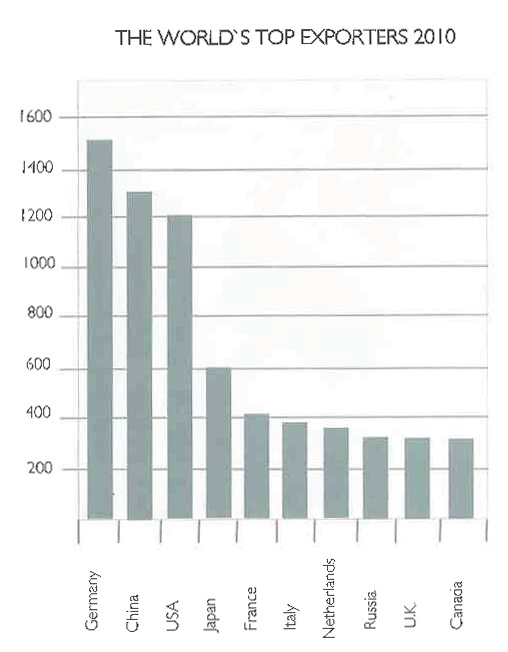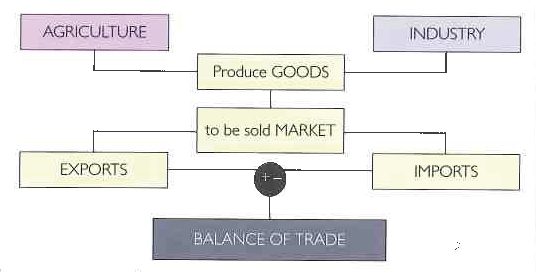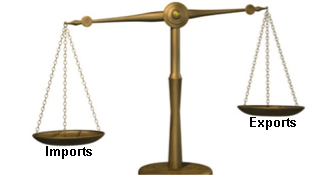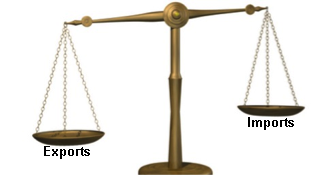Depending on the country, climate, biome, the farming techniques used and the crops grown, the farming system varies from one place to other. These are the most common ones.
Category: Economy
Traditional farming
Traditional farming system is technically and technologically primitive. The land is farmed to provide sustenance; everything that is produced is needed for survival (subsistence).
One fifth of the world farms in this manner, constituting the largest part of world agriculture. Today it is rare for people to live from hunting and fruit gathering. There are also few people whose occupation is nomadic agriculture and animal husbandry.
Characteristics of traditional agriculture:
- Extensive farming with simple tools and crops
- Basic instruments: axe, hoe, stick.
- Methods: burn the plants in a field and sow in the ashes.
- Cattle raisin helps to create fallow land.
- In the absence of private property, public or communal land predominates.
- There is no surplus production.
The number of self-sufficient, family farms is diminishing in the developed countries, but this is not the case in developing countries in Africa and Asia. Nomadic herders are still found in the south of the Sahara Desert in Africa, and across Afghanistan and Lapland. Sheep herding is an important occupation in some areas, such as Mongolia, as a complement to agriculture.
Another form of traditional farming is the intensive farmed rice paddy, of great importance in Southeast Asia. Rice is the most widely planted cereal. Most species require high soil humidity during growth. Rice is cultivated in Asia, South America, Africa, the United States, southern Europe and elsewhere.
Industrial Revolutions
The First Industrial Revolution
The First Industrial Revolution occurred almost exclusively in England, the Second Industrial Revolution spread to other European countries and to other countries (the USA and Japan exclusively), and theThird Industrial Revolution – that took place in the middle of the 20th century. This final one spread industrialisation to the ex-colonies and changed the industrial typology in the advanced countries (Europe, the USA…), due to the appearance of the computer.
The 1st Industrial Revolution was based initially on the development of the English textile industry carried out by non-organised factory workers. Before the 18th century, cloth-making was based on the Domestic System. But when the population of England began to increase rapidly in the 18th century, there was an increased need for the production of cloth, usually made from imported cotton from India.
Many inventions accelerated cotton production, producing more and producing more cheaply. The biggest innovation of all was James Watt’s Steam Engine (1786), applying steam power to the cotton mills. This truly converted England into the “workshop of the world”. Another important aspect of the 1st Industrial Revolution was coal, because steam could be produced by burning coal.
This fundamental shift in power source and use had enormous consequences. Without this shift the world would not have developed as it has done. Without the steam engine, coal could not have been extracted easily, but then the steam engine was applied to the invention of cotton mills, steam ships, trains, steam tractors, and furnaces for making iron and steel. The development of the steam engine changed the shape of society. Because mills or factories did not have to be located near to water
The Second Industrial Revolution
The 2nd Revolution saw a basic shift in the main industrial power source. In terms of cause and effect, we can say that as machines multiplied, more energy was needed. The workforce was mainly qualified and organised by Trade Unions. The coal available was insufficient, and so it was gradually replaced by petrol. The car was invented, and so demand for petrol rose. This caused a revolution in transport, which in turn stimulated new industries and commerce. Steel, for example, was needed for machines, railways, ships, cars, iron buildings etc. As more industrial regions and factories grew, there was a new need for extra finance (capital) which resulted in the growth of banking. With regard to electricity, the principles of electric generation had been established by the Englishman Michael Faraday in 1831, but it was not until 1879 that the American Thomas Edison invented a light bulb. The same year, the first commercial power station was opened in San Francisco. After various electrical domestic inventions in the early 1900s (oven, vacuum cleaner, washing machine) the developed world changed in a radical way.
In fact, a significant characteristic of the 2nd Industrial Revolution was the emergence of the USA and Germany as the new industrial powers to compete with Great Britain. In 1870, when the German state was effectively created, the Rhine and the Ruhr valleys were rich in coal. This stimulated the iron and steel industry, but also the chemical industry, originally based on synthetic dyes and aspirin. The Bayer company became the main protagonist, and by the end of the 19th century Germany was the world leader in the chemical industry, establishing factories across the world.
The Basque Industrialisation
Industrialisation was an important event in the history of the Basque Country, but this neither happened everywhere nor at the same time. Nevertheless, there were some common characteristics. The Industrial Revolution was slow in developing, and began in the middle of the 19th century in Biscay, at the end of the 19th in Gipuzkoa and in the middle of the 20th in Araba and Navarre.
Biscay began to develop rapidly with the incorporation of foreign capital, expansion of the ports, expansion of a new banking network and a new infrastructure with the expansion of the railway. The first modern iron factory in the Basque Country, Santa Ana de Bolueta, S.A. was founded in 1841 and by 1859 there was an Altos Hornos in Barakaldo, and almost immediately the whole Bilbao zone was industrialised. By 1870, Biscay was Europe’s biggest exporter of iron-ore. The iron exports and railway companies also made certain members of the Biscayan industrial bourgeoisie very rich and powerful. This stimulated mercantile activity and the end of the century saw the creation of important shipyards in Sestao (Astilleros de Sestao, Euskalduna de Construcción y Reparación de Buques) and in 1902 the creation of Altos Hornos de Vizcaya, a large and important steelworks. Up to the end of the 19th century and at the beginning of the 20th, many people from other Basque lands and other Spanish territories moved to the major industrial areas of Biscay.
In Gipuzkoa, industrialisation developed differently. There were some iron-based industries, but other related industries also appeared in different areas of Gipuzkoa. Although most of the industries were created from the end of 19th century, some industries were founded in the middle of the 19th century – such as the textile industries of Bergara –1846 Algodonera San Antonio, the paper factories near Oria-1841 La Esperanza in Tolosa, and – Fábrica de Trenes San Martín in Beasain in 1860, the predecessor of CAF (Compañía Auxiliar de Ferrocarril). In the 20th century, La Papelera Española (1902) was founded in Errenteria. In 1906 the Unión Cerrajera in Arrasate was founded, and in 1920 Alfa to make sewing machines. These factories were generally quite small, created with local capital and the workers were from Gipuzkoa.
In Araba and Navarre, and particularly in the Northern Basque Country, industrialisation didn’t begin until middle of the 20th. The exception was the iron ore Forge de l’Adour founded in Bayonne in 1884, that used iron from Biscay and English coke.
Plantation farming
Plantation farming is a form of agriculture practised in or near tropics which originated in colonial times.
The first plantations date from the seventeenth century and existed in the southern USA, Caribbean states, Central and South America.
At first, white labour was used, but later this was replaced by black slaves, who were cheaper. Nowadays wage labourers work on the plantations and large land properties. Crops produced on the plantation are destined for markets; they use single-crop farming techniques such as cocoa, cotton or coffee, but also grow local crops such as bananas, dates, etc.
Plantations are managed like a business, whose goal is the production and marketing of goods. The workers are wage earners with fixed working hours. However, in some places workers still live in conditions similar to the era of slavery.
Single-crop farming creates problems because the product depends on international fluctuations in market prices.
We also call this kind of agriculture speculative farming. If a country depends too much on market fluctuations, this can impede its economic progression.
Mining and forest exploitation in the Basque Country
The mining and the forest exploitation are the least important activities of the primary sector. These activities are carried out close to mineral mines and forests. On the one hand, the mining get raw materials for buildings or road (for instance stones) and on the one hand minerals like magnesite for fertilizers. The most of the forest exploitation establishments are located in Navarre, because there are in this province the most of the forests (Irati, Urbasa, …)
Light industry
Also called consumer goods industry, provides finished products for direct consumption by the population.
Characteristics
- It transforms goods for direct consumption by transforming products of basic industries or agriculture / fishing…
- Food, textile, automobile (cars and car parts) , light chemical products (cosmetic, plastic..) are examples of this.
- The food industry is the most important of these. The freezing or tinning of transformed agricultural products has become highly developed, bringing with it changes in eating habits.
- Electronic industries are mobile phones, computers, calculators, stereos and televisions
- Usually located near large cities and transport links.
- Needs fewer raw materials and energy resources than heavy and capital goods industry.
- They also tend to be less polluting.
International trade: exports
International trade is the exchange of goods and services between one country and another, but depending on how much each country exports or what are the goods that each country exports, the economy of that country can go better or worse.
Usually, MEDCs (More Economically Developed countries) export valuable manufactured goods such as electronics and cars and import cheaper primary products such as minerals, tea and coffee. In LEDCs (Less Economically Developed countries) the opposite is true. So, developing countries sell mainly raw, unprocessed and untransformed cheaper materials. While rich countries sell to them consumer goods such as technology and cars. And the trend in prices favours the rich countries: prices for raw materials are dropping, while manufactured products are still much higher.
Increasing trade and reducing their balance of trade deficit is essential for the development of LEDCs. However, sometimes MEDCs impose tariffs and quotas on imports. Tariffs are taxes imposed on imports, which makes foreign goods more expensive to the consumer. Quotas are limits on the amount of goods imported and usually work in the MEDC’s favour.
EXPORTS % 2010 BY REGIONS
Source: Wto: International trade statistics
- Europa: agricultural products, 9,2%; fuels and mining products, 10,7%; manufactured products, 80,2%.
- Africa: agricultural products, 8,3%; fuels and mining products 72,2%; manufactured products, 19,5%.
Leading export countries worldwide in 2023(in billion U.S. dollars)
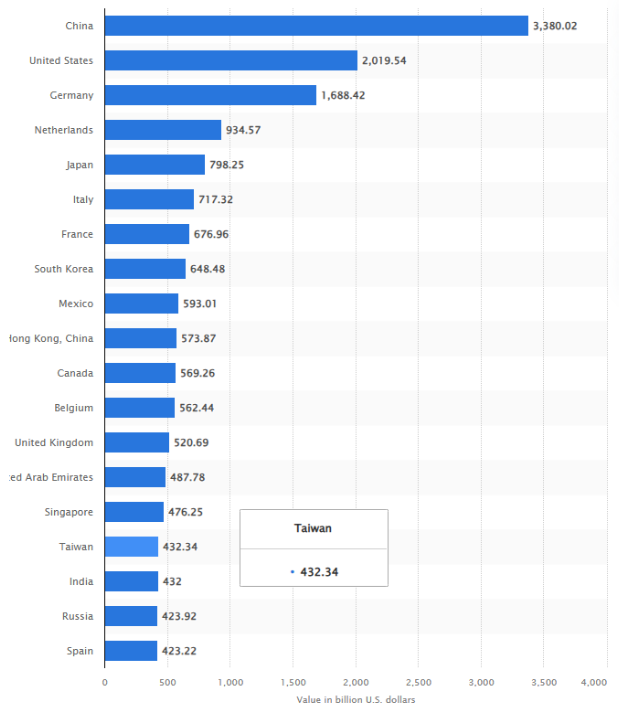
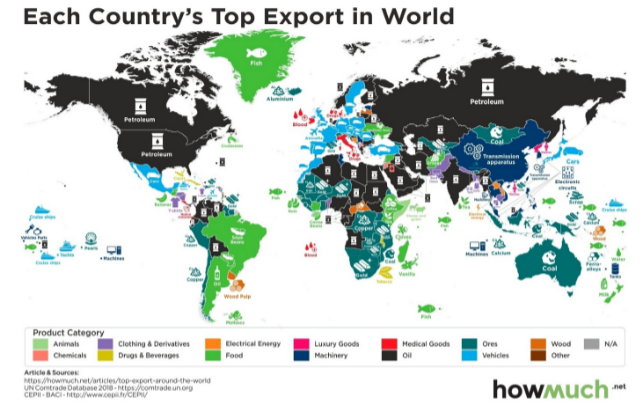
every-country-full-map.html
International trade: balance of trade
Trade balance is the difference between the values of the products that a country sells to other countries (exports), and the cost of the goods that the country buys from abroad (imports) during a particular period (commonly a year).
A trade surplus means that the value of exports is greater than imports. A trade deficit is when there are more imports than exports.
Another useful data is the balance of payments of a country that consists of the record of all economic transactions between the residents of a country and the rest of the world. To calculate it we add to the trade balance, the services, the capital movements (money spend by tourists, sent home by emigrant workers.. and the financial transactions (investments, buys of foreign companies…).
If a country has higher incomes than payments, the balance of payments will be positive and if a country has higher payments, the balance of payments will be negative.
If a country has a negative balance trade, it owes money to other countries, because that means that needs to pay more than it collects and it’s say that country has an external debt.
Foreign trade of the Basque Country. Balance of Trade

Development of Exports and Inports Basque Country and Europe
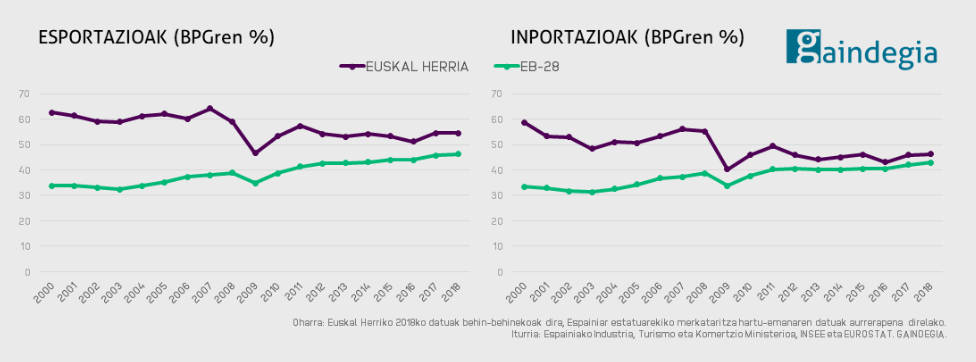
International trade: The world market
International trade is the exchange of goods and services between one country and another.
International trade has been present throughout much of history, starting from the Mediaeval Silk Road or the Transoceanic Trade between Europe and America during the Modern Era, after Europeans arrived to America.
Anyway, the economic, social, and political importance of the international trade has been on the rise in recent centuries.
Nowadays, Mutual dependence between national economies is increasing constantly as international trade grows. Between 1980 and 2010, world trade multiplied by a factor of four. The developed, industrialised countries (Western Europe, USA, China, Canada, Japan…) control 80% of the world trade.
Today, since we all produce, distribute and use products from all over the world, the international economy is like one great market. In this growth of economic relations between countries, the multinationals are particularly influential.
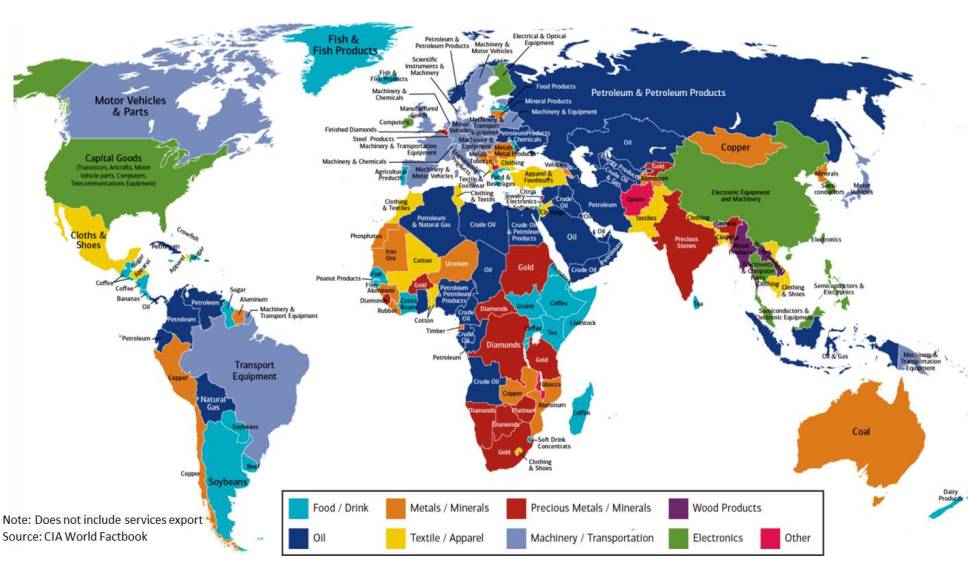
G5Wp92w.png
The most highly developed countries, together with suppliers of certain raw materials such as petroleum and coffee, are the ones with the most trade.
This imbalance contributes t the economic dependence of some countries (mostly developing countries) upon other, developed, countries.
In the resulting situation of inequality between different parts of the world, the developed countries have a double advantage. Not only do a number of transnational / multinational companies have the highest sales figures in the world, bur furthermore their economic strength gives those companies extraordinary power.
Walmart, for example, is the world’s powerful company and the biggest private employer in the world with 2,2, million employees working on 11.500 stores in 27 countries. This retail stores sell food, clothes and almost everything. Its annual revenues (US$ 20.428 billion in 2024), for example, exceed the GDP (the gross national product) of any developing country… Austria United Arab Emirates, Denmark, and Qatar…


